#Vespula germanica
Explore tagged Tumblr posts
Photo


101 notes
·
View notes
Photo
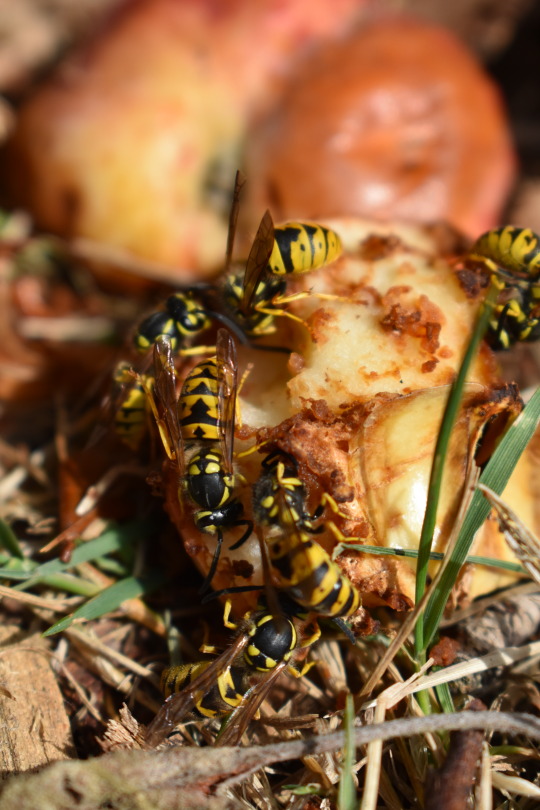
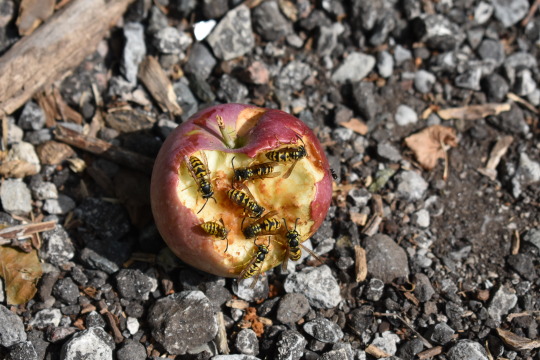
German Yellowjacket Vespula germanica Vespidae
Photograph taken on September 10, 2022, at Spadina Museum, Toronto, Ontario, Canada.
#wildflowers of southern ontario#German Yellowjacket#yellowjacket#Vespula germanica#Vespula#Vespidae#toronto#Ontario#Canada#insect
10 notes
·
View notes
Text
Last of the summer wine: autumn wildlife
#alomena prasina#Arctium minus#autumn wildlife#Caddisfly#Cirsium eriophorum#Common green shieldbug#German wasp#Helina evecta#Helina impuncta#Lesser burdock#Muscidae#Red admiral#Vanessa atalanta#Vespula germanica#Wasps#woolly thistle
0 notes
Note



This little man was drinking the little droplets off my cranberry juice. Andy idea what he is?
Wasp ID - MA, USA:
I'm sorry to say, this is the introduced European Wasp (Vespula germanica), family Vespidae.
Vespula germanica - Wikipedia
62 notes
·
View notes
Text
Did you know that male wasps cannot sting? Males of any Hymenopteran don't have stingers for that matter. There are some male wasps that have what is called a Pseudostinger (like Myzinum, Thynnidae) or sharp genital spines (like Anterhynchium, Eumeninae), but neither deliver venom. A stinger is a modified ovipositor, which is an egg-laying apparatus that only females have. Here, I am holding a male Vespula, I think a very xanthic V. flavopilosa, or V. germanica, which was subsequently released.
#hymenoptera#insect#entomology#wasp#wasps#apocrita#aculeata#vespidae#vespoidea#Vespinae#Vespula#Vespulaflavopilosa#pseudostinger#genitalspines#malewasps
141 notes
·
View notes
Text
WASP REVIEW - WASPS (GROUNDED)


[Image IDs: A screenshot and a render of the wasps from Grounded /End IDs.]
Now this is a game I've been interested in for a while, one that has a rather large and lively cast of bugs throughout it, all viewed from an up close perspective (although one that is often detrimental to the player character)! This, of course, includes plenty of wasps, specifically for the purposes of this review, those directly referred to as Wasps, including the Drones and Queen. Now, some of you who have read these reviews before may be wondering "Ms. Jupiter, doesn't this game also have bees? You usually cover those too, if they're present!", and that is true! I will be covering the bees as well, however, I will be doing so at a later date, alongside the ants! Unfortunately I've neglected ants for some time now (despite also being, taxonomically speaking, wasps, as Formicidae evolved directly from Vespoidea), due to not knowing as much about this subset of species. I'm still learning, but excited to look into them more, so be sure to tune in later for the Grounded revisit!
For the time being, lets start this review the same way we always do, taking a look at their appearance. It's clear to me that the face of this wasp is based directly on the yellowjacket species Vespula germanica, with the distinctive trio of black spots on its clypeus (the broad front sclerite plate above the mandible). The mesosoma markings seem to support this theory, although the metasoma makes things a bit less clear. One could argue those markings do bear some resemblance to the spots on V. germanica as well, although they're far from the same.



[Image Sources: Wikimedia Commons, Entomart, and Wikimedia Commons, no further source information provided | Image IDs: A photo of the face of a Vespula germanica yellowjacket, followed by a screenshot of a dead Wasp in Grounded, followed after that by another image of Vespula germanica, this one in front of a pure white background /End IDs.]
The legs should also have a black marking around the coxa, trochanter, and femur if this is the case. Speaking of the legs, they're mostly accurate, but there should be one more short tarsal segment than there is. The antennae are close as well, but should have more segmentation on the flagellum than they do here. Furthermore, the eyes aren't quite the right shape, and they should be black, rather than the oddly glowing red they are in this game. The presence of ocelli, ie simple eyes, is unclear. Lastly, it's missing some distinct yellowjacket fuzz! Overall, though, I feel like this is close enough to correct! Certainly much closer than last week's example, that's for sure.
Although, these are just the standard Wasps! There's also, for one, the Wasp Queen!


[Image IDs: Two screenshots of the Wasp Queen from Grounded /End IDs.]
It's mostly the same exact story here, except for a few points. Notably, I can see the ocelli on top of the head more clearly on this model, and the initial leg segments have all the black markings they should now! The facial markings, though, while admittedly closer to a real Vespula germanica queen's markings than to a worker's, aren't quite right, with its asymmetrical and oddly placed spots. On top of that, the Queen, for whatever reason, has antennae with a yellow scape and pedicel but black flagellum, when the entire antenna should be black.

[Image Source: NatureSpot, David Nichols | Image ID: A photo of a Vespula germanica yellowjacket, more than likely a queen, on the end of a green-leafed plant /End ID.]
Lastly, we have the Wasp Drones, and, realistically, these guys should look very similar to their sisters, just a bit smaller than the queen and bigger than the workers, and with longer antennae. But, strangely, these guys don't seem to have longer antennae at all, but do have different coloration, with red in place of black, as well as yellow tips on their flagella, on top of having this sort of odd bend in them as well. It honestly brings to mind the mental image of a yellowjacket mixed with an executioner wasp (Polistes carnifex).



[Image Sources: iNaturalist, Eric van drn Berghe, and DeviantArt, Eldar Zakirov | Image IDs: A screenshot of a Wasp Drone from Grounded, followed by two photos, one of a Vespula germanica yellowjacket drone on a small branch, and the other of a Polistes carnifex paper wasp on a wooden board /End IDs.]
I think that's all that can really be said in regards to that, however, so let's now discuss their nesting behaviors, and honestly, it's a little bit strange. There appears to be one main nest, within which the Wasp Queen resides and can be summoned to fight, looking about like a standard yellowjacket nest (enclosed structure, vaguely teardrop shaped), oddly found inside of an old bin. But, there are also much smaller nests found throughout the yard, in a more paper wasp type configuration (open structure, umbrella shaped). This would be entirely normal, if they belonged to different species, of different subfamilies or at different stages of construction, but they don't, and, in fact, every small nest comes with only two Workers and one Drone, with no additional Queens to be found, seemingly all under one collective hive.




[Image Sources: Ohio State University, Joe Boggs, and Flickr, Bob Peterson | Image IDs: A screenshot of the main nest in Grounded, followed by a render of a small nest. These are then further followed by photos of a nest of Baldfaced Hornets, which are actually a type of yellowjacket, and a nest of paper wasps, species Polistes major, subspecies major /End IDs.]
The interior of the main nest is also a little strange, but it's not too far off, appearing to have proper layers of cells on the inside. The nests themselves seem ok, though notably different from each other, but this nesting behavior is odd no matter how you slice it. I've heard of multiple queens/foundresses working together under one hive in some Vespidae/Polistinae species (Polistes fuscatus, Polistes dominula, Parachartergus colobopterus, and potentially others), but not one queen ruling over multiple nests simultaneously.
With regards to their behavior outside of nesting, they seem to be notably more aggressive than the real thing would be towards something as small as the player character (which they're not trying to hunt), at least comparatively to how I've observed wild Vespids to be. I've witnessed various different creatures pass by Vespid nests at relatively close distance with no issue. Speaking of their aggression, each variant of these wasps has its own offensive and defensive behaviors as well!
The standard worker Wasps have the sting and bite you would expect, yellowjackets being known for both while defending and hunting, but they also have... A venom shot projectile. It's odd just how common this is to see in video game wasps! It's an interesting attack, yes, but it's also a notably inaccurate thing, only being an ability found in a select few ants, as mentioned in certain reviews. I do have to mention that there is one alleged incident of an Asian giant hornet spraying venom into someone's eye, but given this appears to be an isolated incident with not a lot of research done regarding it, I'm more inclined to believe this was an instance of incidental venom discharge from an "angry" (defensive) wasp.
When it comes to the Wasp Drones, they have two abilities themselves. One of these is the aforementioned projectile, which is even more odd for them, as male wasps (the drones) do not have venom due to not possessing stingers. The other ability, however, is a scream that applies beneficial status effects to them and their wasps. The ability that they and their sisters have to create somewhat complex vocalizations is odd, as most noise-making wasps have simple stridulating chirps, and these species do not include yellowjackets! Side note, their loot table also includes Wasp Paper, which is something that drones would not typically be out collecting.
Finally, the Wasp Queen mostly has similar attacks, those being stings and projectiles, with a scream that summons worker Wasps and Wasp Drones (usually, in the real world, they'd be summoned to attack with pheromones or just with the fact an invader is in their nest at all). Although she does have a couple more things that can deal damage to the player, the first being landing on the player, and the second being POISON BOMBS, FOR SOME REASON. I don't think I need to tell you guys this, but yellowjackets and other wasps are not capable of producing noxious projectile explosives in the real world.
Now, for the first time in this series of reviews, we get to talk about attack weaknesses! and, strangely enough, these wasps are resistant against Chopping, Stabbing, Slashing, Explosive, and Spicy attacks, but are weak against Salt of all things? I can't speak for real world yellowjackets' ability to take proportionally small explosions and sharp weapons, but insects in general are known for having an extreme distaste for capsaicin. As for salt... I mean come on, they're not snails, it may be harmful if it got into an open wound but they still need salt to live, and are in fact often attracted to sources of salt.
In conclusion, they have quite a few features that are fairly accurate! But they made quite a few decisions that baffle me as someone who takes a loving interest in these creatures. Visually, their markings can be notably off but their body structure is almost entirely accurate, meanwhile their behaviors often quite odd. So, my rating for these wasps would have to be...
-
Overall: 6/10
-
Leave your wasp review suggestion in the replies, tags, or askbox!
34 notes
·
View notes
Text


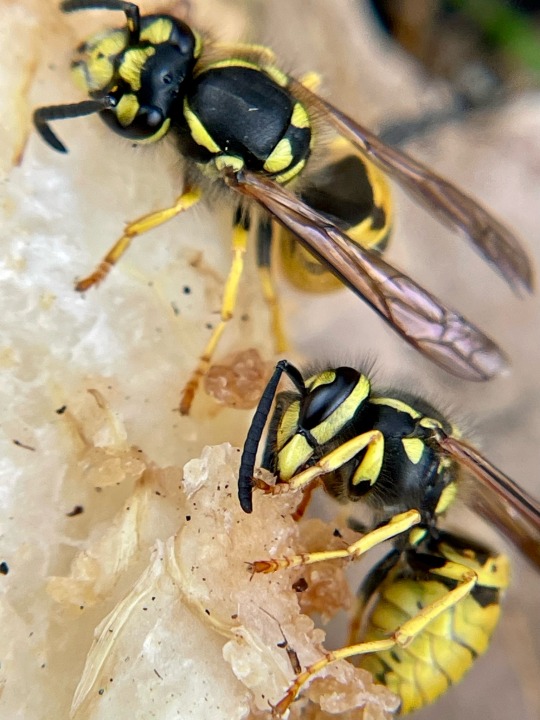
A bunch of German Yellowjacket (Vespula germanica) ladies chomping on some pears.
46 notes
·
View notes
Text
October 12th, 2023
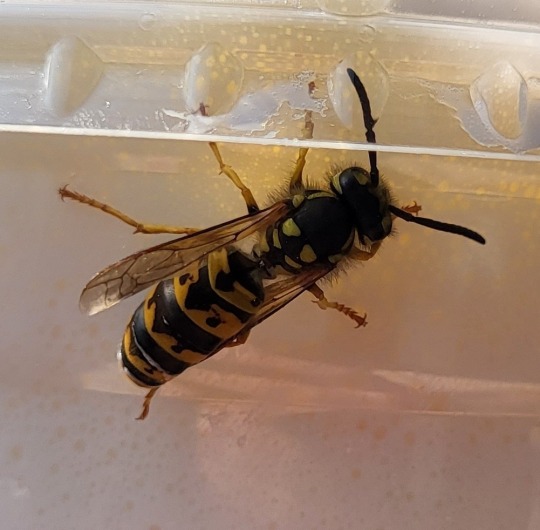

German Yellowjacket (Vespula germanica)
Class: Insecta
Distribution: Found in sections of every continent except Antarctica; native to Europe, Northern Africa and temperate Asia, and introduced to North and South America, Australia, New Zealand and South Africa. Invasive outside of its native range.
Habitat: Primarily ground-nesting in Europe and Oceania, but also nests in voids in buildings in North America. Common in urban and suburban areas, as well as forests.
Diet: Polyphagous scavengers and opportunistic predators; feed on carrion, live arthropods (including spiders), fruit, honeydew, processed human food and garbage.
Description: The German yellowjacket is a destructive, invasive insect outside of its native range, known for outcompeting native wildlife in the search for food. Due to their varied diet, they are able to compete with native biota in the areas it invades, quickly accumulating large population densities in these areas. Nests are built from chewed plant fibres mixed with saliva, and are often confounded with those of the paper wasp, Polistes dominula.
These insects are known to show cognitive plasticity, taking current and past experiences into account when making decisions. They are capable of relocating previous food sources, as well as remove associations with feeders after the removal of a reward. This implies that German yellowjackets have the capacity to learn and remember, as well as recognize landmarks and people. This intelligence is probably one of the many reasons this species is so successful at invading new areas.
(First picture by me, second by Richard Bartz)
59 notes
·
View notes
Text

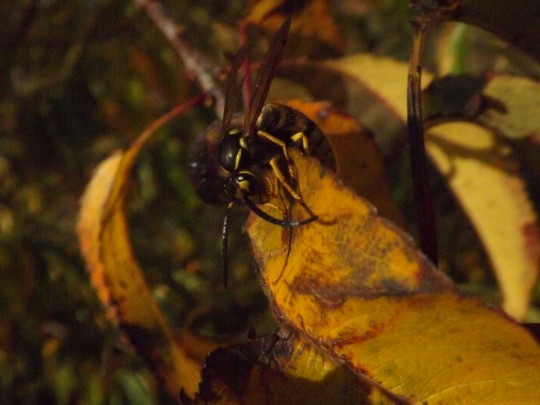
She was a lovely model
Vespula germanica
50 notes
·
View notes
Text
Vespula germanica, the European wasp, German wasp, or German yellowjacket, is a species of wasp found in much of the Northern Hemisphere, native to German bakeries that sell Spritzkuchen
#very educational true facts#quoted straight from wikipedia with no edits#german stuff#sad clown noises#atmposts
79 notes
·
View notes
Text
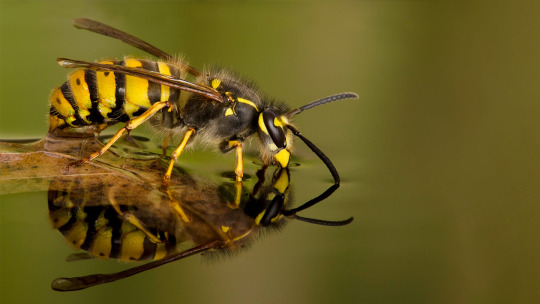

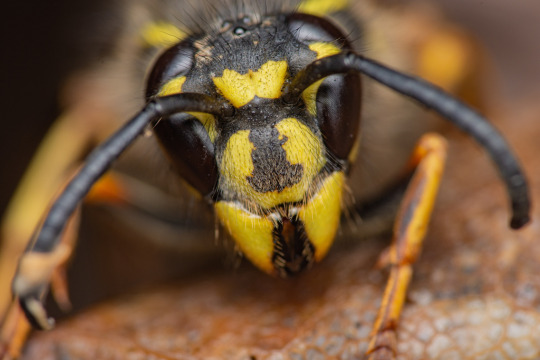
Wonder Common Wasps
The common wasp, Vespula vulgaris is a species of wasp that is native throughout Europe and Asia, and has been introduced in New Zealand, Australia, and South America. These wasps thrive in a variety of environments, from deciduous forests to meadows to urban parks and gardens; the primary requirements are an abundant source of food and at least several months where the temperature is above 2 °C (36 °F) which allows them to forage. Nests can be found in tree hollows, crevices, wall cavities, or any other enclosed space.
Vespula vulgaris has a highly varied diet. As larvae, they are fed pre-chewed caterpillars, flies, spiders, and bees. Adults consume more sugary foods like nectar, fruits, and honey. They find these foods through their extremely sensitive sense of smell; the common wasp is capable of detecting minute particles of food via their antennae, and once a source of food is found the individual will return to the hive to recruit others by drumming their abdomen against the side of the nest.
Like other hymenoptrids, the common wasp is a eusocial species; each nests consists of workers under the direction of a single queen. When a queen first begins her colony, she does most of the work building the nest from chewed wood fibre and laying eggs that produce sterile female workers. As the colony grows, reaching up to 5,000 individuals, the queen begins to produce both female and male workers, each of which performs a specific task for the hive; foraging, caring for the eggs and larvae, feeding the queen, or repairing the nest. These workers are directed by pheromones released by the queen, which is delivered both by air and when workers lick the queen to clean her.
The queen begins laying eggs at the start of summer, in May. Larvae emerge about 5 days later, and spend the next 20-25 days being fed by the queen until they reach full size, at which time they spin a mucus-based cover over their cell and emerge as a mature worker. This cycle continues throughout the summer and early fall, with larger individuals emerging later in the season. A larva's place in the hive also determines its size; the largest larvae, which becomes the queen, is located at the bottom of the nest closest to the entrance. Multiple queens typically hatch in a season, but most leave the nest to start their own colonies. Towards the end of the summer, the queen mates with multiple males and then enters a state of hibernation until the following spring thaw; meanwhile, the workers either starve or are killed by the cold.
Workers and queens are fairly similar in appearance; both sport yellow and black markings across their thorax and abdomen to warn away potential predators. The primary difference is that queens are larger, at 20 mm (0.8 in) long, while workers are only 12–17 mm (0.5–0.7 in). Only female workers have stingers. The species is commonly confused with the European wasp, Vespula germanica, as the two look remarkably similar; the best identifier is that V. vulgaris has only one black mark on its head, while V. germanica has three.
Conservation status: This species has a large, stable population and is considered Least Concern by the IUCN. However, in areas where it has been introduced, it is considered invasive due to predation and competition with native species.
If you like what I do, consider leaving a tip or buying me a ko-fi!
Photos
Andy Sands
Mike Snell
Dennis Maraisis via iNaturalist
#common wasp#Hymenoptera#Vespidae#social wasps#paper wasps#wasps#hymenoptrids#insects#arthropods#deciduous forests#deciduous forest arthropods#grasslands#grassland arthropods#urban fauna#urban arthropods#europe#asia#animal facts#biology#zoology
92 notes
·
View notes
Text

Heute möchten wir mit Euch über Wespen sprechen, denn leider haben diese nützlichen Insekten noch immer einen schlechten Ruf! 😰🐝
Aber zuerst einmal ein paar spannende Fakten über sie: 1.: In DE gibt es über 600 Wespenarten, von denen die meisten unauffällig sind und nicht mit den als lästig empfundenen sozialen, staatenbildenden Wespen verwechselt werden sollten. Besonders bekannt sind die Gemeine Wespe (Vespula vulgaris) und die Deutsche Wespe (Vespula germanica), die oft in der Nähe von Menschen auftauchen.
2.: Einige Wespenarten stehen unter Naturschutz, darunter die Hornisse (Vespa crabro), die als besonders geschützte Art gilt. Hornissen spielen eine wichtige Rolle im Ökosystem, da sie große Mengen an Insekten vertilgen. Auch viele Solitärwespenarten sind bedroht, da ihre Lebensräume durch die zunehmende Bebauung und intensive Landwirtschaft schrumpfen.
3.: Wespen leben in komplexen sozialen Strukturen, ähnlich wie Honigbienen. Ein Wespenstaat besteht aus einer Königin, Arbeiterinnen und Drohnen. Die Königin ist für die Eiablage zuständig, während die Arbeiterinnen das Nest bauen, Larven füttern und Nahrung beschaffen.
4.: Die Nester bestehen aus einer papierartigen Substanz, die die Wespen aus Holzfasern und Speichel herstellen. Je nach Art variieren die Nestgrößen – manche Kolonien umfassen Tausende von Individuen.
5.: Untersuchungen haben gezeigt, dass Wespen erstaunliche kognitive Fähigkeiten besitzen. Sie können Gesichter erkennen, komplexe Aufgaben lösen und sich an vergangene Ereignisse erinnern.
Für die Natur sind sie aus folgenden Gründen von großer Bedeutung: 1.: Wespen ernähren sich von anderen Insekten wie Fliegen, Raupen und Blattläusen, wodurch sie einen wichtigen Beitrag zur Schädlingsbekämpfung leisten.
2.: Aasfressende Wespen helfen dabei, tote Insekten und kleine Tiere zu verwerten und so organisches Material wieder in den Kreislauf zurückzuführen.
3.: Auch wenn sie nicht so effizient sind wie Bienen, tragen sie zur Bestäubung vieler Pflanzen bei.
4.: Wespen selbst dienen als Nahrungsquelle für Vögel, Spinnen und andere Insektenjäger.
Fazit: Wespen sind ein wichtiger Teil der Natur und sollten von uns geschützt werden. Wenn sie Euch also begegnen, bleibt entspannt und erfreut Euch an ihnen, denn stechen werden sie Euch nur, wenn sie sich bedroht fühlen! 😊🐝
Quellen: ➡ LINK 1 ➡ LINK 2 ➡ LINK 3 ➡ LINK 4 ➡ LINK 5
2 notes
·
View notes
Text
#2546-2548 - Sooty Beech Scale, Sooty Beech Mold, and the Common European Yellowjacket


One of the features of the Antarctic Beech forests of New Zealand, particularly on the South Island, is the thick layer of what looks like black moss covering many of the trees. And the ground. And most of the plants in the understory.
The black moss is actually sooty mold, a complex combination of fungi from a variety of different Orders, thriving on the ludicrous amounts of honeydew pumped out by the Sooty Beech Scale Ultracoelostoma assimile. The white filaments sticking out of the mold in the first photo is the anal tube of the scale insects, the longest such tube of any insect. The insect is most abundant on Black Beech Nothofagus solandri (the black in the name is from the mold) and middle-aged trees may lose 80% of the sugars they make to them. Younger trees have smooth bark that doesn't offer safe nooks and crannies for the crawlers, and in mature trees the bark is too thick for the scale insects to drill through.
The honeydew is a keystone feature of the Nothofagus forests - birds, bats, reptiles and insects all feed on the honeydew. Some rely on it. There's at least two species of caterpillar that prey on the scale insects. And a beetle - the only one in its family - that feeds only on the sooty mold.

And then the wasps arrived.

Two species are the problem - Vespula vulgaris (see photo) and Vespula germanica. Both are now more common in the Nothofagus forests then they are anywhere else in the world, and by a horrifying degree. Not only are they getting a diet of pure rocket fuel for much of the year, they then denude the forest of invertebrate life to feed their larvae. By monopolising the honeydew supply they're starving the birds and other animals that need that food supply, especially since introduced mice, rats, and stoats are eating the fruit and seeds of the forest, or turning on the birds when they run out of mice.
St. Arnaud, Southern Alps, New Zealand
#Ultracoelostoma#nothofagus#vespula#vespidae#Coelostomidiidae#sooty mold#sooty beech mold#beech scale insect#sooty beech scale#ascomycetes#keystone species#invasive species#new zealand insect#new zealand fungi#new zealand plant#honeydew#nothofagaceae#st arnaud
4 notes
·
View notes
Text


Vespula germanica (worker?)
First time pinning! i think the thorax pin is a bit lower than it's supposed to be, and her head is tilted too far down, but i think it's a good start
15 notes
·
View notes
Text
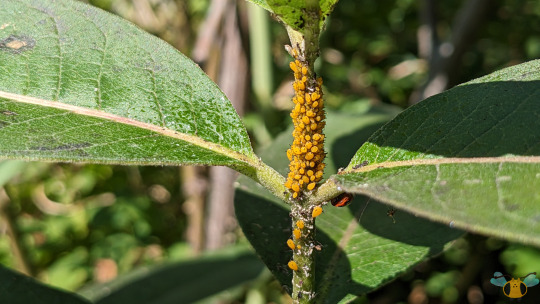
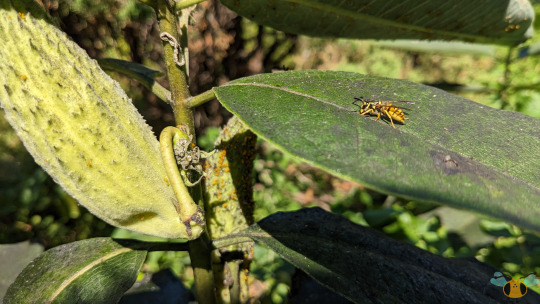
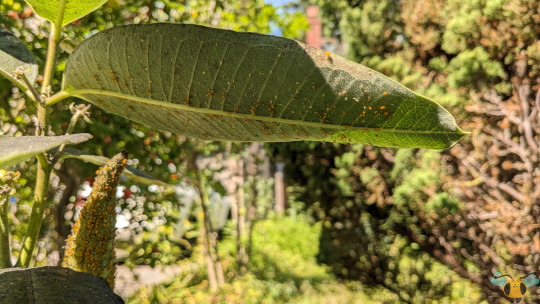
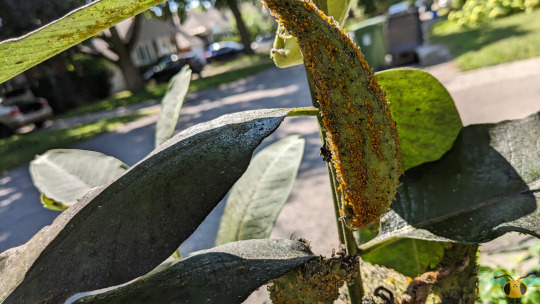
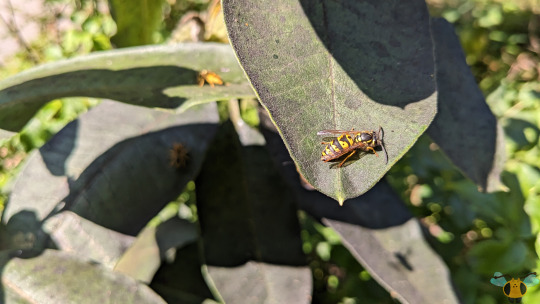
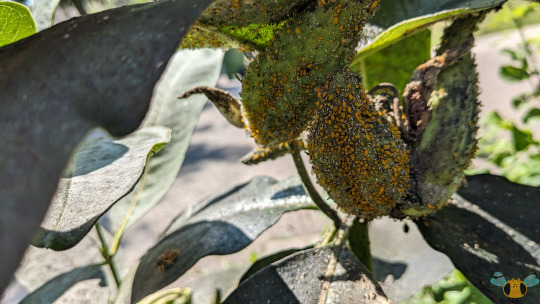
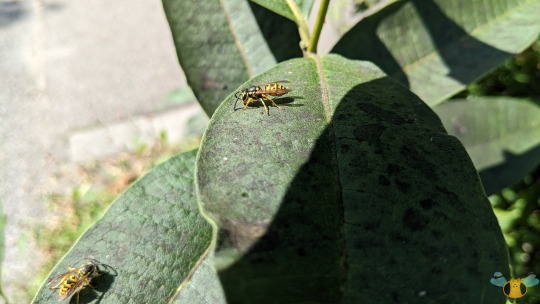
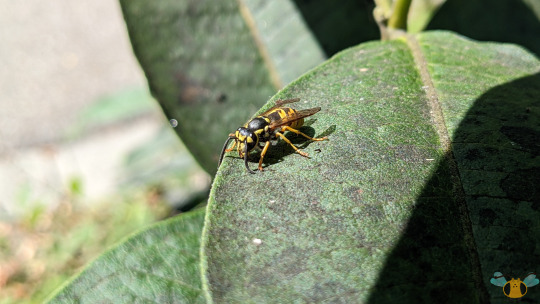

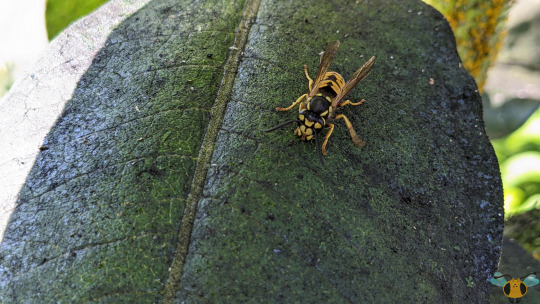
German Yellowjackets and Milkweed Aphids - Vespula germanica & Aphis nerii
While the weather was sunny when these pictures were taken, summer never lasts forever and must always give way to autumn. As such, insect competition for food begins to increase as everyone tries to get their share before the cold sets in. For social insects living in colonies, things are much more precarious since there are many individuals to account for, including developing larvae, the active queen and young queens on the horizon and fertile males later on. These German Yellowjacket (you can tell based on their abdomen's pattern primarily) workers must prevail for their nest and seek out any food sources they can, which is just one explanation for why they like to buzz around barbeques and fruit stores. In this case, these Wasps have found a miraculous (if somewhat dirty) food source coating these leaves. This is the sugary liquid known as honeydew and its presence has attracted fungus to the milkweed, ravaging the leaves with sooty mold. This isn't a pretty picture for gardeners, as mold can be difficult to manage, and the Wasps won't make the matter any easier.
Do note that this type of mold isn't infectious to the plant itself, but the darkening of the leaves can affect the plant's growth and potentially its ability to photosynthesize. This is of little concern to these Wasps as they open their mandibles and hurriedly lap up all the sugary goodness they can! So where did all this honeydew come from? As mentioned on this blog time after time, when herbivorous Hemipterans feed on the inner liquids of a plant, they excrete excess honeydew as a waste product. To satisfy their diets nutritional needs, sap-sucking Plant-Parasitic Bugs must drink a lot of sap. However, the amount of sugar-like nutrients in the sap is too much for such a feeding (protein and minerals are more essential), so the excess sap byproducts are dribbled out from the insect's rear.
One feeding insect may not cause too much of a fuss, but Aphids love to aggregate (it's safer and their parthenogenic reproduction helps speed up the process), so you can visualize based on these pictures what happens when many feed from one leaf. There was evidence of this feeding by way of shed exoskeletons left behind. Not only are Milkweed Aphids feeding from the leaves, but the milkweed seed pods are well, riddling them with fungus. That's just the way of it, one insect feeds and other insects are drawn to the scent of sweet sugar. However, unlike many species of Ants which tend to Aphids and protect them in order to collect the honeydew for themselves, Wasps don't form such relationships. Rather, these Yellowjackets are taking advantage of an opportunity. They aren't tending to the Aphids, but they likely won't bother eating them either, if only for their unpleasant toxicity. Since that's the case, these Aphids shouldn't expect any protection from a Yellowjacket worker, which left them exposed to the hungry Asian Ladybug approaching them in Picture 1.
Pictures were taken on September 3, 2024 with a Google Pixel 4. Happy First day of Autumn!

#jonny’s insect catalogue#ontario insect#wasp#aphid#yellowjacket#german yellowjacket#milkweed aphid#true bug#hemiptera#hymenoptera#sternorrhyncha#insect#insect aggregation#toronto#september2024#2024#first day of autumn#entomology#nature#invertebrates#arthropods#asian ladybug#photography#animals
4 notes
·
View notes
Text





Vespula germanica queen. ❤️
Ottawa, Ontario, Canada. April 17th 2024.
#hymenoptera#insect#entomology#wasp#wasps#apocrita#aculeata#vespoidea#vespidae#vespinae#Vespulagermanica
72 notes
·
View notes